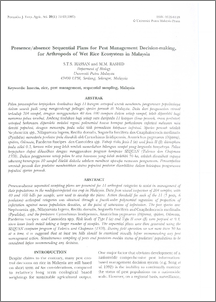Citation
Syed Hassan, Syed Tajuddin and M. M., Rashid
(1997)
Presence/absence sequential plans for pest management decision-making, for arthropods of wet rice ecosystem in Malaysia.
Pertanika Journal of Tropical Agricultural Science, 20 (1).
pp. 51-63.
ISSN 0126-6128
Abstract
Presence-absence sequential sampling plans are presented for 11 arthropod categories to assist in management of
their populations in the multipest-infested rice crop in Malaysia. Data from visual inspection of204 samples, with
40 and 100 hills per sample, were used to develop the plans. Action threshold for each of the 11 (5 pests, 6
predators) arthropod categories was obtained through a fourth-order polynomial regression of proportion of
infestation against mean population densities, at the point of saturation of infestation. The pest species are:
Nephotettix spp., Nilaparvata lugens, Recilia dorsalis, Sogatella furcifera and Cnapholocrocis medinalis
(Pyralidae), and the predators: Cyrtorhinus lividipennis, Anatrichus pygmaeus (Diptera), spiders, Odonata,
Paederus fuscipes and Casnoidea spp. Risk levels of Type I (a) and Type II error ({3) were prefixed at 0.3,
since lower levels entail taking a larger number of samples. The sequential plans were then generated using the
SEQUAN computer program of Talerico and Chapman (1970). During field operation on not more than 50 ha
at a time, it is suggested that at least ten hills should be examined visually before recommending any pest
management action. Simultaneous sampling of pests and predators enables status of predators' populations to be
considered before recommending any decision.
Download File
![[img]](http://psasir.upm.edu.my/style/images/fileicons/application_pdf.png)  Preview |
|
PDF
Presence_absence_Sequential_Plans_for_Pest_Management_Decision-making,.pdf
Download (4MB)
|
|
Additional Metadata
Actions (login required)
 |
View Item |

